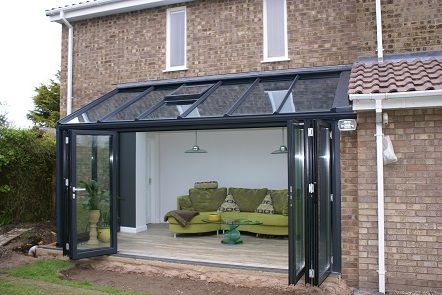Considering a lean to garden room but worried about budget? Get a clear picture of real costs, materials, and essential factors before making your investment.
Understanding Lean To Garden Rooms: The Basics
A lean-to garden room is a versatile structure that attaches to an existing building, typically your house or garage, creating additional living space at a fraction of the cost of traditional extensions. These structures have gained significant popularity in recent years, with installations increasing by 35% in 2023 according to industry data. The fundamental design features a single-pitched roof that ‘leans’ against the main building, offering a practical and aesthetically pleasing solution for maximising outdoor space.
The appeal lies in their simplicity and functionality. Unlike standalone garden rooms, lean-to structures benefit from the existing wall’s support, reducing material and labour costs. They’re particularly popular in the UK due to their ability to provide shelter from our unpredictable weather while maintaining a connection to the garden.
Average Cost Breakdown for 2024
Current market analysis shows that lean-to garden room costs in 2024 vary significantly based on size and specification. Basic installations typically range from £5,000 to £15,000, while premium designs can reach £20,000 to £30,000. Here’s a detailed breakdown of average costs:
- Small lean-to (2m x 2m): £5,000 – £8,000
- Medium lean-to (3m x 2.5m): £8,000 – £12,000
- Large lean-to (4m x 3m): £12,000 – £18,000
- Premium designs with luxury finishes: £20,000+
Key Cost Factors to Consider
Several crucial elements influence the final cost of your lean-to garden room extension. Understanding these factors helps in budgeting effectively and avoiding unexpected expenses:
- Size and dimensions: Larger structures naturally require more materials and labour
- Foundation type: Options range from simple concrete bases (£1,000-£2,000) to complex foundations (£3,000+)
- Material quality: Choose between standard uPVC (most affordable), aluminium (mid-range), or hardwood (premium)
- Glazing options: Double or triple glazing affects both cost and energy efficiency
- Location factors: Site accessibility and ground conditions can impact installation costs
- Design complexity: Additional features like bi-fold doors or skylights increase expenses
Cost Comparison: DIY vs Professional Installation
DIY installation can potentially save 40-50% on total costs, but requires significant skill and time investment. A professional installation typically costs between £200-£300 per square metre for labour alone. Consider these aspects when deciding between DIY and professional routes:
Professional Installation Benefits:
- Guaranteed workmanship and warranties
- Faster completion (typically 1-2 weeks)
- Proper handling of building regulations
- Professional-grade tools and expertise
DIY Considerations:
- Material costs typically £3,000-£8,000
- Required tools and equipment rental
- Extended project timeline (often 3-4 weeks)
- Potential for costly mistakes
Material Costs and Quality Options
Material selection significantly impacts both cost and longevity. Current market prices show:
- Framework: Timber (£30-£50/m²), Aluminium (£80-£120/m²)
- Cladding: uPVC (£25-£35/m²), Cedar (£45-£65/m²)
- Roofing: Polycarbonate (£20-£30/m²), Glass (£150-£200/m²)
- Flooring: Laminate (£20-£30/m²), Engineered wood (£40-£60/m²)
- Windows: uPVC (£300-£500 each), Aluminium (£500-£800 each)
Additional Expenses to Budget For
Beyond basic construction costs, several additional expenses need consideration. Recent industry data suggests setting aside 15-20% of your total budget for these extras:
Essential additions include:
- Electrical installation: £500-£1,500
- Heating solutions: £300-£800
- Insulation: £200-£500
- Interior finishing: £500-£2,000
- Security features: £200-£600
- Lighting: £150-£500
Planning Permission and Building Regulations
While lean-to garden rooms often fall under permitted development rights, there are instances where planning permission is required. Current costs include:
- Planning permission application: £206
- Building regulations approval: £300-£500
- Architectural drawings: £500-£1,000
- Survey costs: £200-£400
Financing Options and ROI
Investment in a lean-to garden room typically adds 5-10% to property value. Financing options include:
- Personal loans: 3-7% APR for good credit scores
- Home improvement loans: 4-8% APR
- Remortgaging: Potentially lower rates but longer-term commitment
- 0% credit cards: Useful for smaller projects
Making the Right Choice for Your Budget
When finalising your lean-to garden room project, consider these budget-based recommendations:
Entry-level budget (£5,000-£8,000):
- Focus on essential features
- Consider DIY installation
- Choose standard materials
- Minimise optional extras
Mid-range budget (£8,000-£15,000):
- Upgrade to better materials
- Include professional installation
- Add basic heating and electrical
- Choose quality windows and doors
Premium budget (£15,000+):
- Opt for high-end materials
- Include luxury features
- Install advanced climate control
- Add custom design elements
Remember that investing in quality materials and professional installation often proves more cost-effective long-term, despite higher initial costs. Regular maintenance can extend the life of your lean-to garden room and protect your investment.
FAQ
Do garden rooms need a concrete base?
While a concrete base offers stability and durability, it might not always be necessary. Concrete bases are not the greenest of choices and are a more expensive choice. Other options include concrete piles, ground screws and concrete pads.
Are plastic shed bases any good?
The benefits of choosing a plastic base are numerous. Not only is a plastic gravel base lightweight and cost-effective, but it also offers superior drainage efficiency, ensuring that your shed remains dry and damage-free.
What is the cheapest base for a garden room?
A concrete base is the most permanent and durable base for a garden building but a paving slab base is cheaper and more popular.
Sources
[1] https://gardensgalorescotland.co.uk/help-and-advice/how-to-construct-a-sheltered-lean-to/
[2] https://www.cs-gardenoffices.co.uk/lean-to
[3] https://www.youtube.com/watch?v=0YTnPUx_G4k


